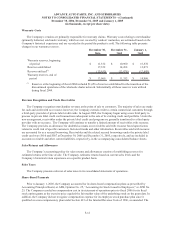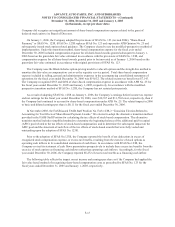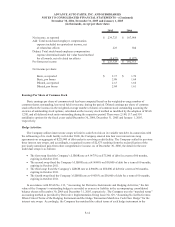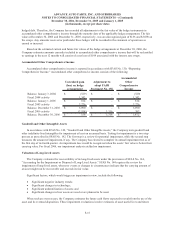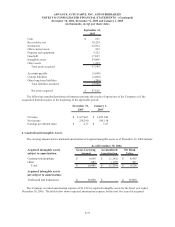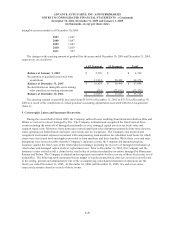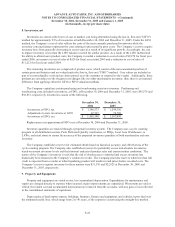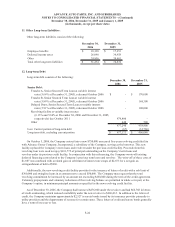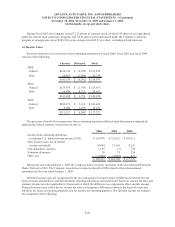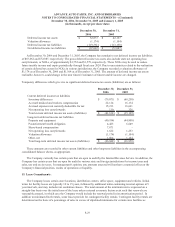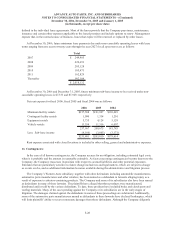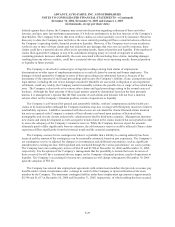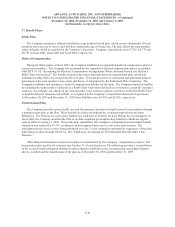Advance Auto Parts 2006 Annual Report Download - page 85
Download and view the complete annual report
Please find page 85 of the 2006 Advance Auto Parts annual report below. You can navigate through the pages in the report by either clicking on the pages listed below, or by using the keyword search tool below to find specific information within the annual report.
ADVANCE AUTO PARTS, INC. AND SUBSIDIARIES
NOTES TO CONSOLIDATED FINANCIAL STATEMENTS – (Continued)
December 30, 2006, December 31, 2005 and January 1, 2005
(in thousands, except per share data)
8. Inventories, net
Inventories are stated at the lower of cost or market, cost being determined using the last-in, first-out ("LIFO")
method for approximately 93% of inventories at both December 30, 2006 and December 31, 2005. Under the LIFO
method, the Company’s cost of sales reflects the costs of the most currently purchased inventories while the
inventory carrying balance represents the costs relating to prices paid in prior years. The Company’s costs to acquire
inventory have been generally decreasing in recent years as a result of its significant growth. Accordingly, the cost
to replace inventory is less than the LIFO balances carried for similar product. As a result of the LIFO method and
the ability to obtain lower product costs, the Company recorded a reduction to cost of sales of $9,978 for fiscal year
ended 2006, an increase in cost of sales of $526 for fiscal year ended 2005 and a reduction to cost of sales of
$11,212 for fiscal year ended 2004.
The remaining inventories are comprised of product cores, which consist of the non-consumable portion of
certain parts and batteries and are valued under the first-in, first-out ("FIFO") method. Core values are included as
part of our merchandise costs and are either passed on to the customer or returned to the vendor. Additionally, these
products are not subject to the frequent cost changes like our other merchandise inventory, thus, there is no material
difference from applying either the LIFO or FIFO valuation methods.
The Company capitalizes certain purchasing and warehousing costs into inventory. Purchasing and
warehousing costs included in inventory, at FIFO, at December 30, 2006 and December 31, 2005, were $95,576 and
$92,833, respectively. Inventories consist of the following:
December 30, December 31,
2006 2005
Inventories at FIFO, net 1,380,573$ 1,294,310$
Adjustments to state inventories at LIFO 82,767 72,789
Inventories at LIFO, ne
t
1,463,340$ 1,367,099$
Replacement cost approximated FIFO cost at December 30, 2006 and December 31, 2005.
Inventory quantities are tracked through a perpetual inventory system. The Company uses a cycle counting
program in all distribution centers, Parts Delivered Quickly warehouses, or PDQs, Local Area Warehouses, or
LAWs, and retail stores to ensure the accuracy of the perpetual inventory quantities of both merchandise and core
inventory.
The Company establishes reserves for estimated shrink based on historical accuracy and effectiveness of the
cycle counting program. The Company also establishes reserves for potentially excess and obsolete inventories
based on current inventory levels and the historical analysis of product sales and current market conditions. The
nature of the Company’s inventory is such that the risk of obsolescence is minimal and excess inventory has
historically been returned to the Company’s vendors for credit. The Company provides reserves when less than full
credit is expected from a vendor or when liquidating product will result in retail prices below recorded costs. The
Company’s reserves against inventory for these matters were $31,376 and $22,825 at December 30, 2006 and
December 31, 2005, respectively.
9. Property and Equipment:
Property and equipment are stated at cost, less accumulated depreciation. Expenditures for maintenance and
repairs are charged directly to expense when incurred; major improvements are capitalized. When items are sold or
retired, the related cost and accumulated depreciation are removed from the accounts, with any gain or loss reflected
in the consolidated statements of operations.
Depreciation of land improvements, buildings, furniture, fixtures and equipment, and vehicles is provided over
the estimated useful lives, which range from 2 to 40 years, of the respective assets using the straight-line method.
F-22


